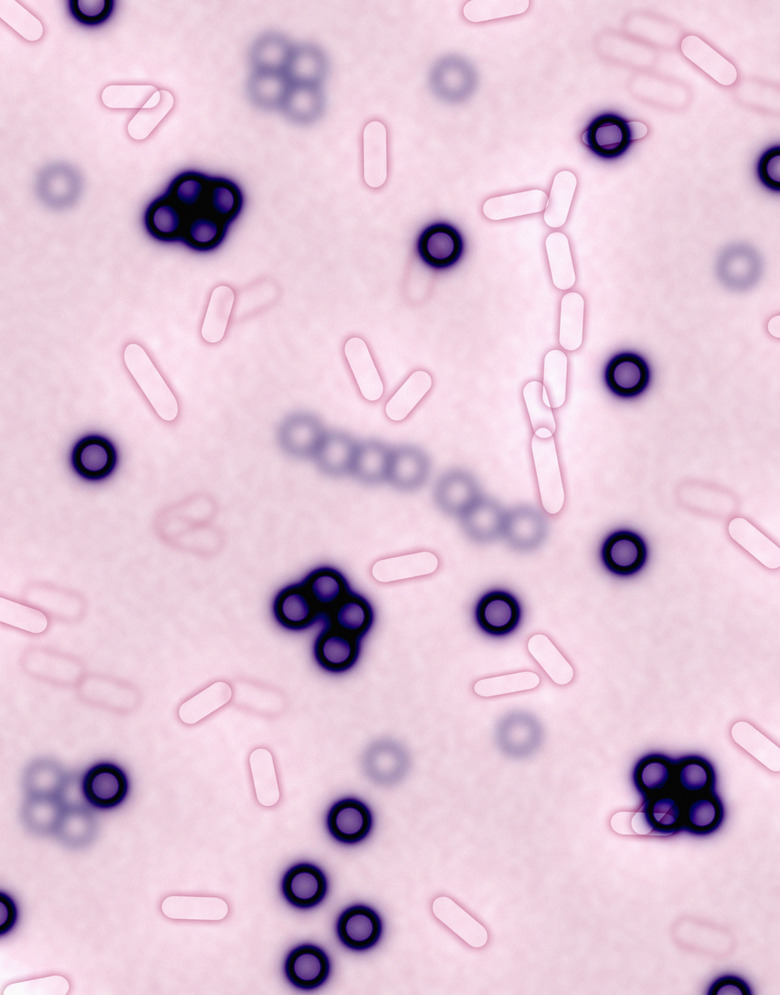What Features Do Mitochondria And Bacteria Share?
About 1.5 billion years ago, primitive bacteria took residence inside larger cells, resulting in an intimate relationship that would mold the evolution of more complex, multicellular beings. The bigger cell was eukaryotic, meaning it contained organelles — structures surrounded by membranes, but the prokaryotic bacterial cell had no such arrangement. The bigger cells feared oxygen, a poison to their existence, but the smaller cells used the oxygen to make energy in the form of the molecule adenosine triphosphate, or ATP. The eukaryotic cell enveloped the bacteria in predatory fashion, but somehow, the predator did not digest the prey. Predator and prey became mutually dependent. Former Boston University biologist Lynn Margulis cited this endosymbiotic scenario in her theory of the origin of mitochondria, the energy factories of cells, and the reason for their numerous similarities to bacterial cells.
Size and Shape
Size and Shape
Based on appearance alone, scientists can draw a relationship between mitochondria and bacteria. Mitochondria have plump, jellybean-like shapes, similar to the rod-shaped bacilli bacteria. The average bacillus ranges between 1 and 10 microns in length, and the mitochondria of both plant and animal cells measure in the same range. These superficial observations constitute one line of evidence supporting the theory that primitive eukaryotic cells had engulfed bacterial cells, forming mutually beneficial relationships.
Method of Division
Method of Division
Bacteria reproduce in a process called fission; when a bacterium reaches a pre-determined size, it pinches itself in the middle, creating two organisms. In eukaryotic cells, mitochondria replicate themselves in a similar process. The cell's command center, or nucleus, signals the cell to produce organelles, usually in advance of a cell-dividing event; however, only mitochondria — and the chloroplasts of plants — replicate themselves. While other organelles can be made from substances within the cell, mitochondria and chloroplasts must divide to increase their numbers. When the energy supply in the form of ATP becomes depleted, mitochondria divide to make more mitochondria for energy production.
Membrane
Membrane
Mitochondria possess inner and outer membranes, with the inner membrane consisting of folds called cristae. Bacterial cell membranes have folds called mesosomes that resemble the cristae. Energy production takes place at these folds. The inner mitochondrial membrane contains the same types of proteins and fatty substances as the bacterial plasma membrane. The outer mitochondrial membrane and the cell wall of bacteria also contain similar structures. Substances flow rather freely in and out of the outer membranes of mitochondria and the outer cell walls of bacteria; however, both the mitochondrial inner membranes and plasma membranes of bacteria restrict the passage of many substances.
Type of DNA
Type of DNA
Both prokaryotic and eukaryotic cells use DNA to carry the code to make proteins. While eukaryotic cells carry double-stranded DNA in the form of a twisted ladder called a helix, bacterial cells have their DNA in circular loops called plasmids. Mitochondria also carry their own DNA to make their own proteins, independent of the rest of the cell; like bacteria, mitochondria also incorporate their DNA into loops. An average mitochondrion contains between two and 10 of these plasmids. These structures contain the necessary information to run all processes, including replication, within the mitochondria or bacteria.
Ribosomes and Protein Synthesis
Ribosomes and Protein Synthesis
Proteins perform all functions within cells, and the manufacture of proteins, or protein synthesis, constitutes one of the major functions of the cell. All protein synthesis occurs solely within spherical structures called ribosomes, which are scattered throughout the cell. Mitochondria carry their own ribosomes to make the proteins they need. Microscopic and chemical analyses reveal that the structure of mitochondrial ribosomes appears more similar to bacterial ribosomes than to ribosomes of eukaryotic cells. Additionally, certain antibiotics, while innocuous to eukaryotic cells, affect protein synthesis in both mitochondria and bacteria, indicating that the mechanism of protein synthesis in mitochondria is similar to that of bacteria rather than eukaryotic cells.
Cite This Article
MLA
Dinh, Ho-Diep. "What Features Do Mitochondria And Bacteria Share?" sciencing.com, https://www.sciencing.com/features-mitochondria-bacteria-share-11399115/. 24 April 2017.
APA
Dinh, Ho-Diep. (2017, April 24). What Features Do Mitochondria And Bacteria Share?. sciencing.com. Retrieved from https://www.sciencing.com/features-mitochondria-bacteria-share-11399115/
Chicago
Dinh, Ho-Diep. What Features Do Mitochondria And Bacteria Share? last modified March 24, 2022. https://www.sciencing.com/features-mitochondria-bacteria-share-11399115/
